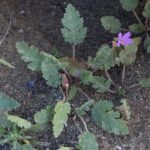Ερωδιός ο βαδύσχιστος
Etymology of Erodium laciniatum: The name of the genus, "Erodium", derives from the Ancient Greek "ἐρωδιός" [erodios], meaning "heron", due to the long beak on the fruit that gives rise to some of its common names such as storksbill and cranesbill, a meaning reinforced by the family name Geranium, the derivation of which is "γερανός" [yeranos or geranos], meaning "crane". Latin "laciniatum" means "deeply divided", and refers to the leaves.
At least nine Erodium species and subspecies/kinds have been recognized in Cypriot nature so far.
Although it is encountered all around Cyprus, Erodium laciniatum is less common compared to most Erodium kinds in Cyprus. It is encountered up to a maximum altitude of merely 150 metres. It usually blooms between January (or later) and May.
How to identify Erodium laciniatum:
Erodium laciniatum has unique upper leaves that distinguish it from the other Erodiums. They are 2-7 cm long, oblong to broadly ovate, very variously dissected: undivided and irregularly serrate, or with 3 pinnatifid lobes, or almost bipinnatisect with linear-lanceolate segments. Most importantly, laciniatum's leaves are not divided into distinct leaflets.


